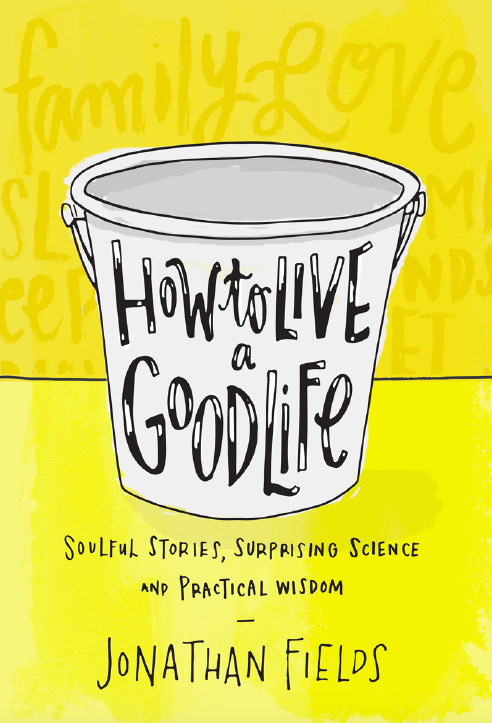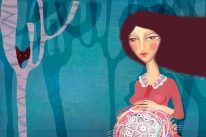 UPDATE – The winners for this giveaway are:
UPDATE – The winners for this giveaway are:
- Joshira Maduro
- Gerardo Corripio F
- sian e lewis
What do you think it means to “live a good life”? Though we all have different answers based on our unique values and preferences, it’s likely yours involves peace of mind, love, fulfillment, and perhaps making a positive difference in the world.
Author and entrepreneur Jonathan Fields has a similar definition—encompassing vitality, connection, and contribution—and he’s explored it in his new book How to Live a Good Life: Soulful Stories, Surprising Science and Practical Wisdom.
I’m a huge Jonathan Fields fan because he’s genuine, humble, and equally devoted to being a change maker as he is to being a husband and dad.
On top of that, he uses his experience to help people stop living on autopilot and start living healthier, happier, more mindful, engaged lives.
He writes in an accessible, down-to-earth tone, not as a guru or expert standing above people, but as a fellow human being who’s dealt with the same challenges we all face. And he beautifully blends relatable stories with practical advice, backed by scientific research.
From the Amazon page:
Drawn from the intersection of science, spirituality, and the author’s years-long quest to learn at the feet of masters from nearly every tradition and walk of life, this book offers a simple yet powerful model, the “Good Life Buckets”—spend thirty days filling your buckets and reclaiming your life.
Each day will bring a new, practical yet powerful idea, along with a specific exploration designed to rekindle deep, loving, and compassionate relationships; cultivate vitality, radiance, and graceful ease; and leave you feeling lit up by the way you contribute to the world, like you’re doing the work you were put on the planet to do.
How to Live a Good Life is not just a book to be read; it’s a path to possibility, to be walked, then lived.
I’m grateful that Jonathan took the time to answer a few questions about his book, and that’s he’s offered three free copies for Tiny Buddha readers.
The Giveaway
To enter to win one of three free copies of How to Live a Good Life, leave a comment below. You don’t need to write anything specific. “Count me in!” is sufficient, but if you feel inclined, share an act of kindness you recently did or witnessed.
You can enter until midnight PST on Friday, October 21st.
The Interview
In your new book, How to Live a Good Life: Soulful Stories, Surprising Science and Practical Wisdom, you dance between modern science and Eastern philosophy. Where does this come from?
Yeah, I have this weird wiring. My rational brain is always looking for data, scientific validation. I don’t just want to experience something, I want to know how it works. But, then the other side is fascinated by nuance, philosophy, traditions and practices that go back thousands of years, with a pretty strong focus on Buddhism.
What’s really cool is that, the deeper I go into both worlds, the more they’ve been coming together. I’ve spent a lot of time researching literature from the field of positive psychology or what many have come to know as the science of happiness. Turns out, many of the practices that this emerging field end up studying, then validating, are tied in some way to Buddhism or Eastern lineages.
Mindfulness is the perfect example. It’s been around for thousands of years, because it works. Now, science is showing “how” the practice works, revealing everything from the ability to grow brain cells to cultivating calm in the face of stress, also known as life!
You share a model of a good life you call the Good Life Buckets. What are they and why do they matter?
Despite stunning advances in knowledge, information, technology, medicine, and industry, the human condition has remained largely unchanged for the better part of thousands of years. What I came to learn is this: We already know how to live better lives; we have all the tools and strategies at our fingertips. We just do anything with them. We don’t act on them.
So, I began to ask why and discovered that so much information is delivered in a way that either forces people to make big disruptive changes (which they’ll rarely ever do), buy into a new and disruptive set of beliefs/dogma (again, that’s a huge ask that’s almost always a non-starter), or wade through complexity that takes serious time and work just to figure out what to do, let alone do it.
We don’t have the patience, the will, or the time for this, so instead, we just bail. We surrender to mediocrity and malaise. I realized I needed to share what I’ve learned over fifty years of life and time spent with hundreds of astonishing, embodied teachers. But, I also needed to do it in a way that went down easy. A way that people could hear once, remember for life, then have it guide their daily behavior.
That’s where the simple model of the Good Life Buckets comes in. Think of your life as three buckets: Vitality, Connection, and Contribution. Your Connection Bucket is about cultivating relationships. Your Vitality Bucket is about optimizing your state of mind and body. Your Contribution Bucket is about contributing to the world in a way that is deeply aligned with who you are and what matters.
Your quest is to keep all three as full as possible. When your Good Life Buckets are full, life is amazing. If any one runs dry, pain ensues. If two run dry, you are in a world of hurt. If all three ever empty at the same time, you’re no longer alive, by any definition.
So, your job is to wake up, ask yourself, which bucket needs a little love today, then go about doing a little something to fill it, while also remembering never to abandon the others. It’s really that simple. Actually, it’s deceptively, yet remarkably effective. And, it doesn’t require you to blow up your life or spend days, weeks or month trying to understand what to do.
I also realized in writing the book that I wanted to hold people’s hands and get them started. This is why after sharing the buckets, the rest of the book is set up as a series of thirty single days. Each offers a simple story and an idea, something to fill one bucket just a bit. Then it dishes up a bit of science to validate the idea and, most important, it invites you to take a simple action designed to fill that one bucket that day.
You don’t even have to believe it’ll work. Just do it and let your experience be your proof. Do this for thirty days and you begin the “live the buckets.” They become a part of you and guide your behavior.
You begin to ask, “Will this fill or empty my buckets?” If yes, you do it, if not, you walk away. Which is the other really big benefit. The buckets become a simple tool to let you know what to say or no, too. That, alone, removes a lot of stress and creates time for the stuff that matters most.
One of the things you focus on is cultivating awareness. Why is this so important?
Because it’s the foundation for choice. We’ve come to live so much of life reactively. We’re filling every moment of every day reacting to what other people want from us, what other people decide is important, what other people want their stories to become. Somewhere along the way, without intending it, we’ve given up control, surrendered our sense of intentionality.
One thing I’ve learned, a good life is not a reactive life. It is an intentional life.
But, we can’t be intentional until we’ve cultivated an ability to “touch down” in our lives. We need to be able to notice where we’re placing our efforts and attention at any given moment in time, before we can choose whether to keep them there, or shift to something more meaningful.
So, for me, cultivating awareness is the starting point. It’s why it’s one of the first chapters. My own practice is a traditional, breath-oriented mindfulness practice. I sit for thirty minutes every morning. Over time, this morning practice weaves its way into the balance of your day. It makes it easier to touch down in your life at different moments through the day, see what’s real and what’s distraction, then make the move from surrender to intention.
As part of the rollout of your new book, you’ve also launched an initiative to plant trees. What’s that about and why does it matter so much to you?
I think it comes from this deeper sense that we’re all a part of something bigger than just us that we benefit from, and are also beholden to it. Whenever I launch something new, I try to make it not just about the “thing,” but also about an opportunity to harness the energy of creation to make a bigger difference.
With the launch of How to Live a Good Life: Soulful Stories, Surprising Science and Practical Wisdom, I decided to partner with a foundation that lets us plant trees for every book ordered by October 18th. My not-so-secret goal is to plant 10,000 trees. I’ve committed to funding the first 2,000 myself. As I write this, we’re almost halfway there.
This is also personal for me. As a kid, I learned early on that nature was my reset. It’s where I’d go to find grace, especially when things got stressful. I got curious about whether it was just me, or whether there was something bigger going on. So, I researched the phenomenon in writing the book.
Turns out, nature, especially trees, not only heals the planet (and we need that desperately right now), it also has a powerful effect on both our psychology and physiology, lowering stress, anxiety, and even markers for inflammation and disease risk. I wrote an entire chapter about what it does to us and how we can bring more of it into our lives.
There’s another reason. We’re losing trees at an alarming rate through fire and industry. And, though we try to be as respectful as possible in sourcing paper, books also use trees. So, this tree-planting mission just made sense to me. If we can pull it off, it’ll be the first book that will plant more trees than it uses, help use live better lives, and serve something bigger than just us along the way.
Any final thoughts?
Just that I’m so grateful to have this opportunity to share ideas here. To know that you and the beautiful Tiny Buddha community are out there making a real difference in people’s lives is wonderful. So, thank you. And to everyone reading, go hug someone, take a moment to breath, cultivate calm, move your body, make meaning and don’t forget to laugh a little along the way.
Lots of love!
+++
Jonathan Fields is a NYC dad, husband, founder of Good Life Project and author of the new book, How to Live a Good Life: Soulful Stories, Surprising Science and Practical Wisdom.
FTC Disclosure: I receive complimentary books for reviews and interviews on tinybuddha.com, but I am not compensated for writing or obligated to write anything specific. I am an Amazon affiliate, meaning I earn a percentage of all books purchased through the links I provide on this site.
About Lori Deschene
Lori Deschene is the founder of Tiny Buddha. She started the site after struggling with depression, bulimia, c-PTSD, and toxic shame so she could recycle her former pain into something useful and inspire others to do the same. You can find her books, including Tiny Buddha’s Gratitude Journal and Tiny Buddha’s Worry Journal, here and learn more about her eCourse, Recreate Your Life Story, if you’re ready to transform your life and become the person you want to be.
- Web |
- More Posts













 Though I run this site, it is not mine. It's ours. It's not about me. It's about us. Your stories and your wisdom are just as meaningful as mine.
Though I run this site, it is not mine. It's ours. It's not about me. It's about us. Your stories and your wisdom are just as meaningful as mine. 